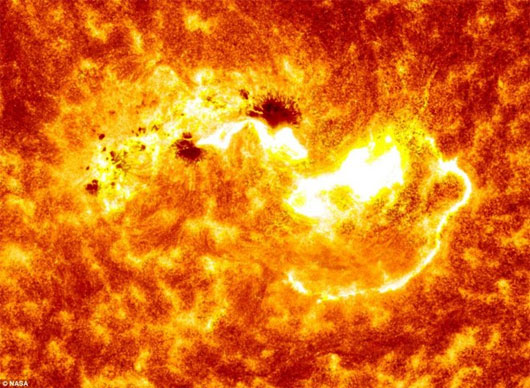The spacecraft delayed flying because of the solar storm
A powerful storm on the sun's upper atmosphere makes a spaceship a vessel unable to leave the launch pad.
The first solar storm in 2014 occurred at 18h32 on January 8 at GMT, which is 1: 32 minutes this morning in Vietnam time. The US space agency (NASA) believes that new black marks appear on the surface of the sun the largest in the past decade.
According to the Daily Mail, plasma explosions on the sun's upper atmosphere release charged particles. They rushed and approached the earth within 8 minutes. The ionosphere of the earth's atmosphere absorbs most of the charged particles from the sun. However, magnetic storms can still affect telecommunications equipment and grid systems.
Concerned about the impact of magnetic storms, Orbital Sciences Group postponed plans to launch a private Cygnus spacecraft to the International Space Station (ISS). Orbital Sciences made this decision when the Antares rocket was on the launch pad at NASA's Wallops space center.

NASA officials classified the first 2014 solar storm to reach X1.2.(Photo: NASA)
'We canceled the plan to launch the Cygnus spacecraft due to an unusually high density of charged particles. Solar storms threaten the electronic system of boosters and spacecraft, increasing the risk , "Orbital Sciences said.
As predicted, the first solar storm of the year will peak in today and tomorrow. It has the ability to directly affect the earth.
Magnetic storms have the ability to interrupt the operation of GPS satellites, satellite communications or satellite television. However, this solar storm does not threaten the safety of the six astronauts working on the International Space Station.
- These photographs amazed solar storm
- Sun planes delayed flying to Morocco
- The most spacecraft flying near the Sun will be launched in 2018
- What is solar storm?
- The US urgently withdraws rooms from the solar storm
- This is what happens if the Sun storm is strong enough to erase the technology of mankind
- Solar storm is about to land on earth
- The solar wind is flying to the earth
- Just appeared solar storm
- Is the giant hole in the Sun really scary?
- NASA Voyager 1 spacecraft comes to the edge of the solar system
- Solar Storm is about to affect the Earth
 Van Allen's belt and evidence that the Apollo 11 mission to the Moon was myth
Van Allen's belt and evidence that the Apollo 11 mission to the Moon was myth The levels of civilization in the universe (Kardashev scale)
The levels of civilization in the universe (Kardashev scale) Today Mars, the sun and the Earth are aligned
Today Mars, the sun and the Earth are aligned The Amazon owner announced a secret plan to build a space base for thousands of people
The Amazon owner announced a secret plan to build a space base for thousands of people